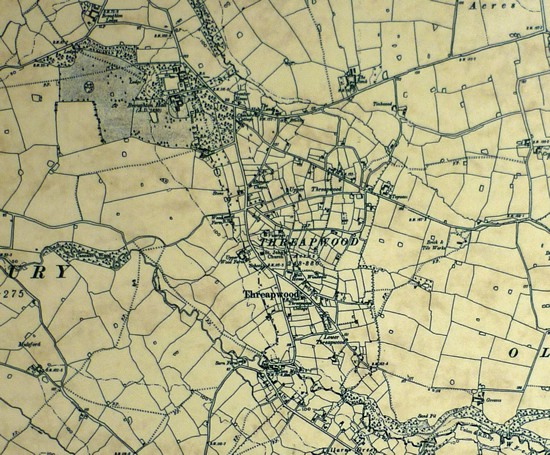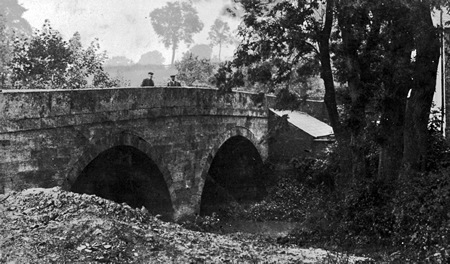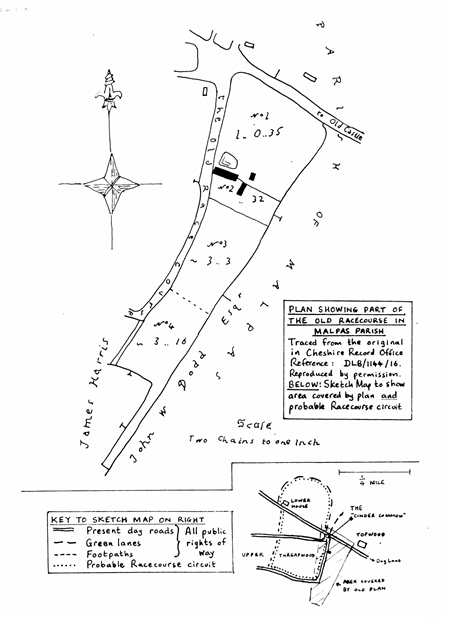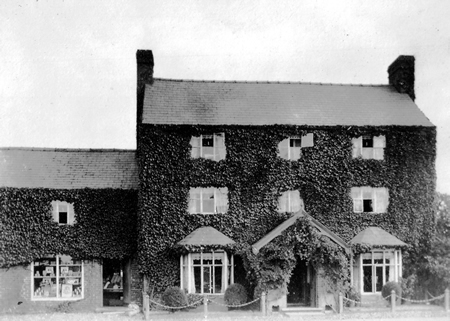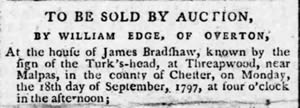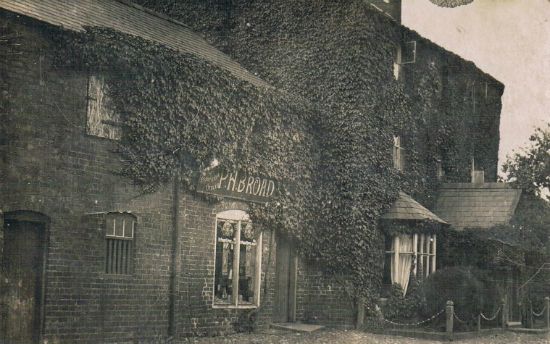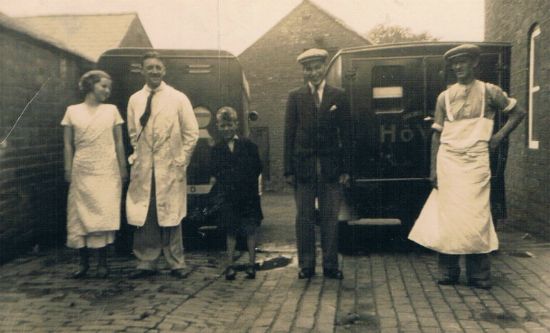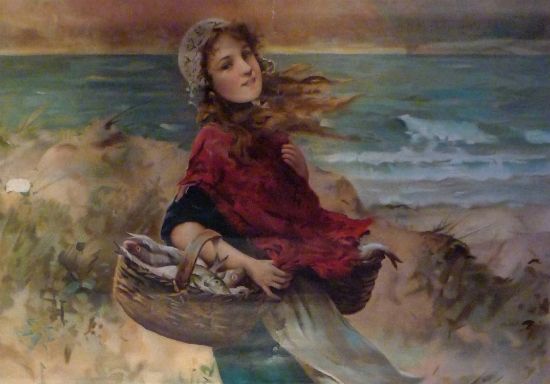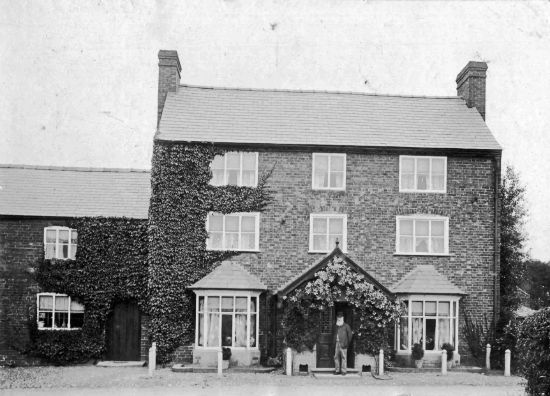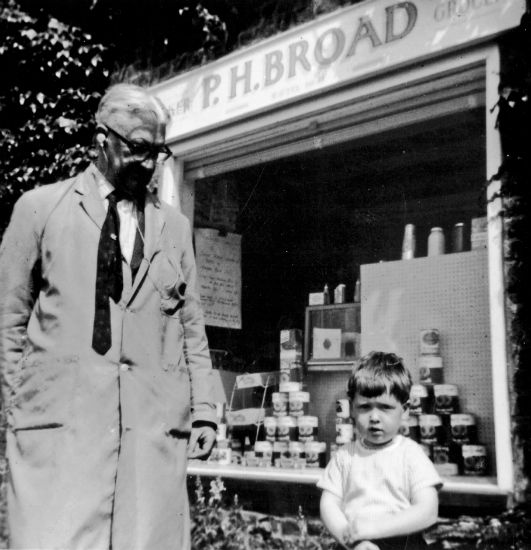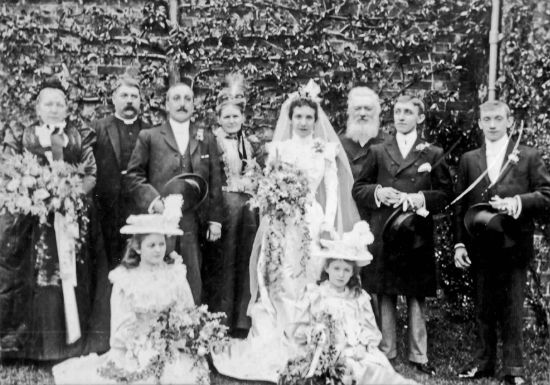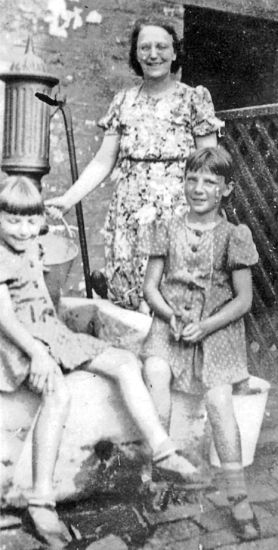Threapwood Past
Location
Threapwood is a small village and civil parish in the unitary authority of Cheshire West and Chester and the county of Cheshire, England. It is 3 miles WSW from Malpas and adjacent to the parishes of Hanmer and Worthenbury. |
View Larger Map |
|---|
In the 18th Century the area of Threapwood was 300 acres. By the mid 19th Century 228 acres resided in Flintshire with 150 acres in Cheshire. By the time of the boundary change in 1896 there were 248 acres in Cheshire of which 1 acres was apparently water.
Derivation of Threapwood
Threapwood, which was formerly an extra parochial place, is on the line of one of the old Roman roads leading to Chester. Up until 1817 Threapwood was dependent on Worthenbury for the offices of religion, as children were usually baptised there and their funerals took place in Worthenbury churchyard.
The name Threapwood means 'disputed wood' although another explanation is that it derives from the Saxon word 'Threp' meaning a ford, referring to a ford on the road crossing the Wych Brook (formerly called the River Elf) at the Sarn. Sarn means a road or a causeway, which probably crossed the brook a little higher upstream than the present bridges. The road itself may well be of Roman origin and what might be another slight deviation can be seen in the field opposite to the entrance to the old vicarage.
Thomas Pennant (Welsh Antiquary 1726 till 1798) derived Threapwood from the Anglo-Saxon Threapian ie., one who persisted in an argument right or wrong; and this derivation may be thought appropriate as the inhabitants resisted all government and even the excise laws.
Archdeacon Thomas wrote that "Threapwood is an ecclesiastical district, partly in Flintshire and part in Cheshire, and was formed out of the old Domesday forest of Broughton, portions of which have been annexed to the parishes of Malpas and Worthenbury, comprising an area of about 240 acres as belonging to no parish".
A Refuge of Immorality and Lawlessness
One look at a map shows Threapwood to be distinctly different from its neighbouring parishes for it is much smaller, yet it contains a bewildering maze of roads, green lanes and paths. Between these lie a patchwork of small fields with an even scattering of small farms and houses. The smaller, mainly 19th century cottages are gradually altering out of all recognition as they are rebuilt, expended and modernised. The history of Threapwood too is very different from that of the surrounding parishes for until 1857 it was an extra-parochial place -a sort of 'no man's land' lying between Cheshire and Flintshire. In 1874 Archdeacon Thomas wrote "Being extra-parochial, it had formerly an unenviable notoriety as a refuge of immorality and lawlessness but of this character it has for some time been clearing itself.
The situation in Threapwood is best illustrated in a letter from Philip Henry Warburton, M.P. for Chester since 1747, to Lord Chancellor Hardwicke;
Chester August 4th 1753
My Lord
It is by your permission that I trouble you with the present state of a place called Threapwood or Common lying between the Counties of Flint and Chester, reputed to be in no County, Parish, Town or Hamlet It contains about three hundred acres, the greatest part of which is waste land but very improvable, the rest is covered with seven and twenty cottages and small enclosures, and the inhabitants of these cottages were about two months ago numbered at one hundred and fifty.
It is mostly encompassed by the Parish of Worthenbury, in Maylor Hundred, in the County of Flint. On the Cheshire side is the Parish of Malpas. I find this place mentioned in the Acts of Parliament for pressing soldiers in Queen Ann's reign, certain persons being there assembled to avoid being pressed for soldiers, which Sir Joseph Jekyll then Chief Justice of Chester obtained a clause that the Commissioners for executing those acts in the County of Chester might have the like power in Threapwood. And as I was apprehensive that the same inconveniences might again happen, the like clause was obtained upon my motion in the House of Commons in a Press Act which passed in the last Parliament. I do not find this place mentioned in any other Act of Parliament, law book or Case whatsoever.
As the cottages and enclosures in this place cannot be assessed to the Land Tax in any County, neither do the inhabitants pay any rate or tax whatsoever except the Ale sellers, who by the influence of the Flintshire Gentlemen were brought under the Duty of Beer and have paid that duty now-about twenty years. The Right of Common for cattle upon the waste lands of this place have been constantly and immemorially used by the Inhabitants of the several adjoining Townships that lye in the County of Chester and Flint. As neither the Sheriff of Chester or Flint were ever known to exercise the office in this place, so no offence, criminal or capital, committed in this place can be tried in either of those Counties or anywhere else I apprehend.
The same inconvenience with regard to the jurisdiction of Justices of the. Peace and as there is no County in which any ejectment can be brought, where can the right, if there be any, to the cottages and enclosures exist but in the present occupants? I have heard that in former Reigns, particularly in King William's time, applications have been made to the Great Seal, by Private persons for grants of this place no doubt with a view to enclose the Whole and render it private property. But if ever there were such Grants, it is most certain they never were submitted to and; in all probability never will, by the Inhabitants of the several Townships mentioned above who have time out of mind exercised their right of Common for cattle upon this place.
It is, my Lord, as an obstruction to public Justice and that some effective way may be found out to have the Laws put in execution in this Place. That the Peace may be kept, and good order observed in Threapwood as in other parts of His Majesties Dominions: are the reasons for submitting these facts to your Lordships consideration by;
Your most obedient and most humble servant
Philip Henry Warburton
Lord Hardwicke, in his reply, expressed concern that such a place could exist but recalled that he had heard Sir Joseph Jekyll speaking of "a spot of ground in that County called 'debatable land' and continues "The nature of the case speaks strongly that such a place must be the seat of much Disorder and Irregularity and the asylum of many disorderly persons to the interruption of Justice of which it is surprising that one has not heard more complaints. It is laudable in you to have turned your thoughts to the redress of such an inconvenience and I shall be very ready to co-operate in any proper measures for that purpose.
As Warburton states, Threapwood was annexed to the County of Chester for the purpose of the Press Act, the reason being "As that disturbance began in the County of Chester it was well considered that their own Towns Officer might be able to quell it in the most easy expeditions. Moreover, several of the commissioners lived near the place and the castle of Chester the nearest Gaol was computed just ten miles off".
The enclosure of Threapwood appears to have taken place in a piecemeal way, as shown in a letter of 1786 from Thomas Roylance, agent for the Drake Estate;
"Since I last walked the boundaries of Threapwood there is at least ten acres more enclosed, Mr Davis of Broughton this year has enclosed full three acres, on the Welsh side the said common. If an Act of Parliament could be got to enclose this common it would be of service to Mr Drake - about a year ago an exchange was proposed between Mr Drake and Mr Leech, which I thought equitable, of the land separated by the new cut.... now he (Mr Leech) declines the exchange. Mr Leech said he would buy those bits at the same price the commissioners paid for land taken from Mr Drake into the road,"
The 'new cut' or road probably ran from Frontier House towards Malpas. The Reverend Sir Gresby Puleston in his book 'A Quiet Country Parish' writes of life in Threapwood at about this time. He recalls talking to an old man who told him that cock -fighting, drinking, swearing and bull baiting were their pleasures. As all of these my old friend confessed, with a twinkle in his eye, that he had "joined but nothing worse". And of course there were also the Threapwood Races (see below).
Although Warburton appears to have set the wheels in motion for the "annexation of Threapwood it was not the first attempt. Other papers in the Clwyd Record Office at Hawarden, undated and unsigned but believed to relate to the early 18th century, contain a remonstrance from the inhabitants of Worthenbury 'as to why that the common called Threapwood should not be wholly annexed to the Township of Cuddington in Malpas Parish in Cheshire'.
The reasons are as follows:
First, though it is allowed that the aforesaid Wood or Common does lye betwixt the two Counties of Flint and Chester yet the boundaries of the Flintshire side are of greater extent than the Cheshire side, and that part of the wood or common that adjoins to the Parish of Worthenbury is near twice as much as that adjoining to the Township of Cuddington in Malpas Parish.
Second, Whereas there is but one cottage and three tenements, none exceeding Thirty pounds per annum in the Cheshire side of the wood, and but one of those in the Parish of Cuddington, that have their riding or driving ways directly to or over the said wood. There are on the Flintshire side seven houses inhabited by freeholders and tenants beside a Gentleman’s house and a large Demesne that have no other way out upon sufferance either to church or market but upon and over the above named wood.
'Third, There is a very great road from Shrewsbury, Ellesmere and Hanmer leading to Chester which road is from one end of the said common to the other; and on their way upon the said common are two bridges, one of two large stone arches over the river Elf. The other stone and timber; both which bridges are built and constantly repaired by the Inhabitants on the Flintshire side without any assistance of the Township of Cuddington in the Parish of Malpas in Cheshire.
'And further as the freeholders of the Parish of Worthenbury do hope to have their rights and privileges to the Common of Threapwood continued to them and their heirs, so, they much desire that some effectual way may be found out to have the Laws put in execution, and that peace may be kept and good order preserved there, as in other parts of her Majesties Dominions. 'If this Common called Threapwood were acred and measured with regard to the Freeholders on both sides the Common aforesaid and so, one side of the Common be accounted in Cheshire and the other side in Flintshire it would be of great advantage to the Flintshire side, for now, all people come whence they will, claim Common Pasture for small cattle on Threapwood; and Tho' there are several cottages erected on the wood the cottagers pay nothing to any Person or Persons.
'These reasons are again humbly offered in behalf of the small Parish of Worthenbury in the County of Flint which at present by reason of its vicinity to a lawless place is more oppressed with poor than any of its neighbouring Parishes. It encompasses the greatest part of Threapwood and has the greatest resort of strangers'.
It would seem that the problems of Threapwood with its undesirable characters were spilling over into Worthenbury. Puleston mentions an entry in the diary of Philip Henry, grandfather of Warburton, in 1682 whereby Broughton Hall "was robbed last week, and the thief taken and hanged". The poor, in particular married mothers and their children would drift to Threapwood after being subjected to movement orders from neighbouring parishes where they had become a burden on the Poor Rate.
Pennant (1778) says of Threapwood "from time immemorial a place of refuge for the frail fair who make here a transient abode clandestinely to be freed from the consequences of illicit love. Numbers of houses are scattered over the common for their reception".
Before the building of the church in Threapwood these children would have been baptised at either Malpas or Worthenbury. Of those at Worthenbury, Mrs Sunter Harrison remarks:
"Many of the illegitimate births were not registered, but over many years a sexton of Worthenbury church kept a note book and put down a great number of baptisms in it, but they do not appear in the church registers. The Puleston family purchased the note book from the sexton's widow and placed it for safe keeping with the registers".
Before his death in 1760, probably shortly after the letter of 1753 Warburton signed a petition to the House of Commons along with W. Drake and Thomas Salusbury in which they asked -the House 'to take the premises into their consideration and to make such provision as to the House shall seem meet'. Also in Warburton's papers are the headings for an intended Act of Parliament whereby Threapwood was to be annexed to the Parish of Worthenbury. However it appears that the earlier idea put forward by the inhabitants of Worthenbury was adopted - Bryant's map of 1831 shows .the county boundary dividing Threapwood. The Cheshire part was nearly twice the area of that on the Flintshire side and the 1851 Census returns show that of the 97 occupied properties 66 were in Cheshire. The total population was 385.
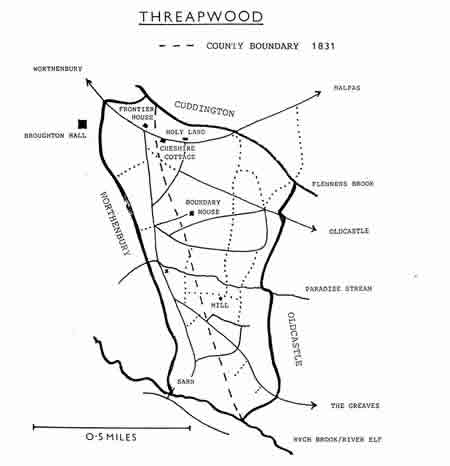 Map showing 1831 Cheshire Flintshire boundaries
Map showing 1831 Cheshire Flintshire boundaries
In 1896 the Flintshire part of the parish was transferred to Cheshire. Of the two bridges mentioned earlier, built and maintained by the inhabitants of Worthenbury, the stone and timber bridge over Paradise Stream (by the church) has long since been replaced by a brick culvert with the road raised on an embankment over it. The Sam Bridge was built in 1627 and it is interesting to note that under the two oldest arches the blocks of stone in each course are numbered, indicating that the masons John and David Smith dressed the stone to size, probably at the quarry, before bringing it to the site for erection. In 1819 another pair of arches was built to more than double the width of the bridge.
Sarn Bridge is pictured above circa 1920 with two unknown local men posing for the photographer.
Threapwood Races
About twenty years ago in researching the history of the Malpas area local historians Eddie Broad, Gerrard Barnes and David Hayns discovered interesting details about the Threapwood Races.They have kindly given their permission to include it here. Most interesting perhaps is a copy of a handbill which reads as follows:
Worthenbury Wake and Threapwood Races 1800
Will be on Monday and Tuesday the 29th and 30th September 1800. On Monday the 29th will be run for on The Holy Land at Thomas Hughes a piece of plate, value Fifty pounds. On Tuesday the 30th will be run for by Ponies at Jane Richards a piece of plate, value Fifty Pounds. Each of the above plates are subject to Articles.
Every Horse to be entered on each Morning before eleven o'clock, or pay double Entrance at the Post and start each evening exactly at three o'clock. Not less than three to start.
Balls, Assemblies and great public and private Diversions. Bull and Bear Baiting as usual.
N.B. All Tailors seen on Horseback on the Course, will be taken up and whipped.
Those that won't come shan't see it.
Further investigations revealed that at this time horse racing probably took place on the "Old Racecourse" on the patch of ground known today as the "Cinder Common" in Threapwood lying between Lower House and Topwood. Here there is a curious green lane (now a public footpath) which runs in a rough semi-circle and which, together with the road, encloses Lower House. This is the first mention of Bull and Bear Baiting in the neighbourhood, while the value of the prizes (plate worth £50) and prizes of 25 guineas on some occasions, seems to indicate that racing was well established.
It was certainly well patronised by the gentry as can be seen by an item in Rev. Sir T. H. Greasley Puleston's History of Worthenbury published about 1890. This names 25 gentlemen including Lord Molineux, Sir Robert Cotton, Sir William Williams and Sir Rowland Hill, all who subscribed a guinea.
"They ran for a purse,value 25 guineas, each starter paid £2.2.0. and they were started by a trumpeter who had a fee of five shillings."
This appears to relate to an occasion other than that in 1800. It seems that many rural meetings were held from the seventeenth century onwards.
Further evidence of horse racing at Threapwood can be seen in Cheny’s Kalendar of 1728 and 1729. Images are reproduced below of various references to racing at Threapwood in the years 1728 and 1730.
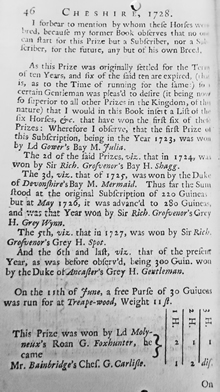 |
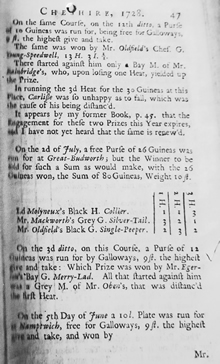 |
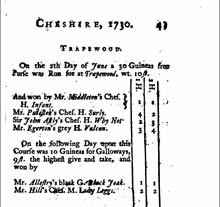 |
Threapwood Mill
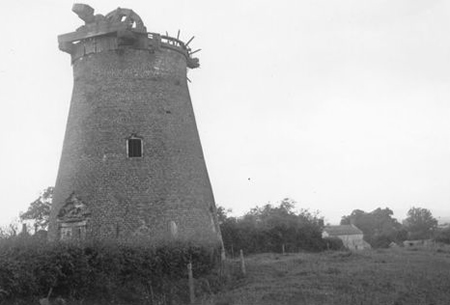
A well known landmark in Threapwood is the Grade II listed windmill pictured right. It is a brick, bottle shaped tower mill dating from the early eighteenth century. The three storey structure with door openings and arched windows had a tapering wooden dome. Parts of the sail platform and wheel mechanism are in situ but much of the structure has fallen in and is in a bad state of repair. The mill was still in use in the 1880's and would have been used to mill corn for animal feed as were the mills along the Wych Brook. The original Miller's cottage stands close by but is also in a derelict state. Click here for more
The Holyland
Another well known property in Threapwood is the Holyland which has seen service as a Shop, Public House and Domestic Dwelling. Pictured right, in a photo from the early 1900's, is the shop adjoining the main house. In it's days as a public house during the 19th century it was known as "The Grapes". The original pub sign has been saved and is shown in the photo below (left). The following list of Licencees has been supplied by Jill Lewis;
- Jane Harper 1822-23
- Jane Hughes 1825
- William Wilson 1826-28
- James Rowson 1851
- Edward Broad 1871-91
The earliest reference to its use as a pub is 1822 and the Licence was relinquished in l891.
Another interesting artefact from the Holyland is the Fire Insurance Mark1 pictured below (right). Buildings without the necessary mark and insurance could not expect to enjoy the services of the local fire brigade. Photos Courtesy Jill Lewis.
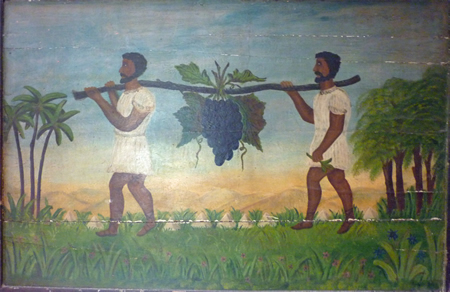 |
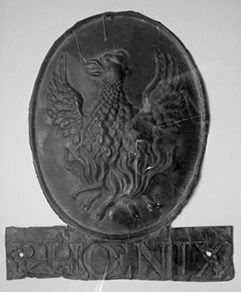 |
|---|
The property probably came into the Broad family about 1871 but they had a grocery business there from 1841. Edward Broad was a local entrepreneur. He ran the Pub, had a grocery business, owned the Sarn Mill, Threapwood Brickyard and a small farm. He was also a moneylender.
He and Sarah his wife (nee Payne) had a family of five boys and two girls. As the family grew they added a third storey in the 1870s. The Boys were very mischievous and played some pranks on the Clientele of the Pub. It is said that one customer was asleep in a chair in the Bar and was tied to it, woke up and staggered off up the road with it muttering curses!.
This for sale notice (right) dated to 1857 confirms that James Rowson was still in occupancy of the Holyland as a Public House in 1857. The notice also confirms the former name of the Holyland as being "The Grapes" public House. Photo courtesy of Tom Langley. Newspaper advertisements over the years have confirmed the existance of other Threapwood "pubs" such as this sale notice below for a pub known as "The Turks Head" from the Chester Courant of 29th August 1797.
The precise location of the "Turks Head" is unknown. |
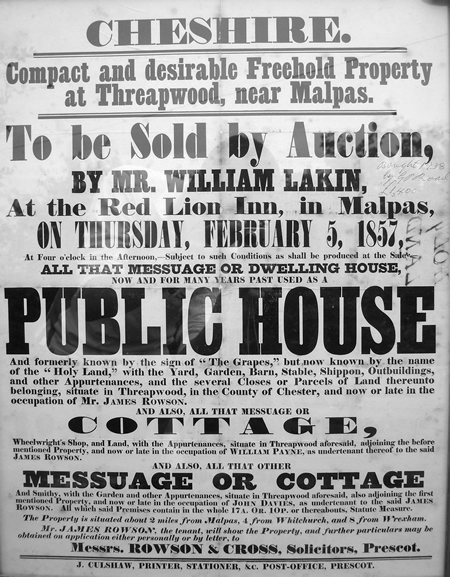 |
Broads Shop
Following it's time as a pub the Holyland became the village shop known to all locally as "Broads". Philip Henry Broad came into the grocery Business started by his father Edward and in the 1920s Philip's son Geoffrey Broad and his family took it on. They baked and delivered by vans around the surrounding area.
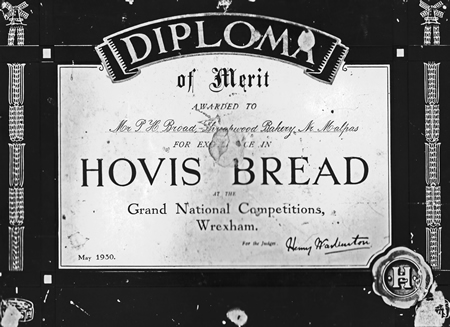 |
The still familiar name of Hovis Bread was baked on the premises as this Diploma of Merit from 1930 testifies. |
The business closed in 1972 and the Holy Land became a private house and still remains in the Family. The Gallery below contains a number of photographs of the Broad family from these times.
|
{image.index}/{image.total}
|
The White Cottage
The first documented reference to this cottage in Threapwood is a Conveyance dated 26th September 1828 recording the transfer of ownership from the trustees of Robert Tudan to Charles Philips for the sum of £48.0. A timeline recording its subsequent history up to 1968 can be viewed by clicking here.
Threapwood Garage
This photograph from the early 1900's shows Threapwoods Garage. Some of the local inhabitants are pictured, although they seem to be favouring pedal power over the combustion engine. Located on the road between Malpas and Bangor on Dee the garage will have been a popular place as the motor car grew in popularity during the 20th century. Photo Courtesy of Ron Jones.
References
References to Threapwood abound in the book "The story of a quiet country parish, being gleanings of the history of Worthenbury, Flintshire (1895)" by The Rev Sir T H Gresley Puleston. The book can be read online or downloaded by clicking here.
Gallery of Photographs
Check out the Gallery Page which has a selection from all the photographs loaned or donated to the group.

